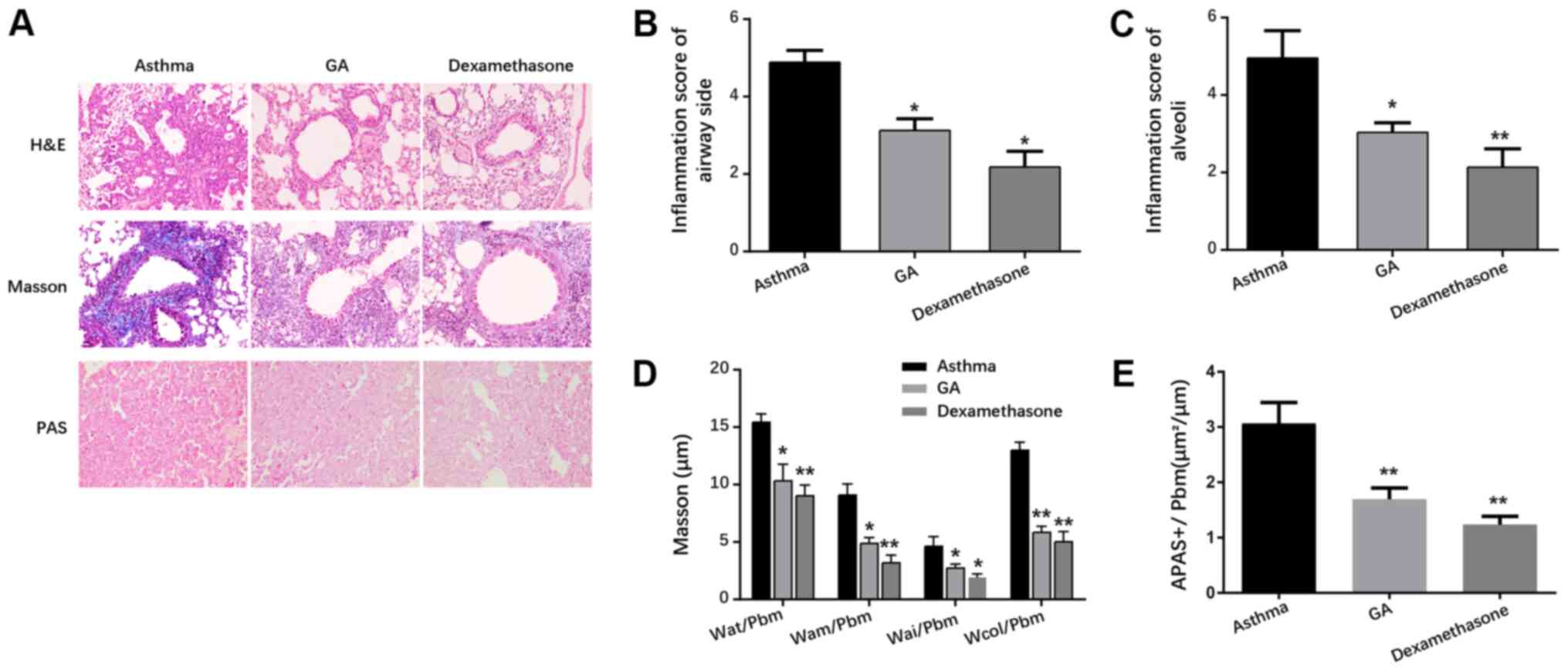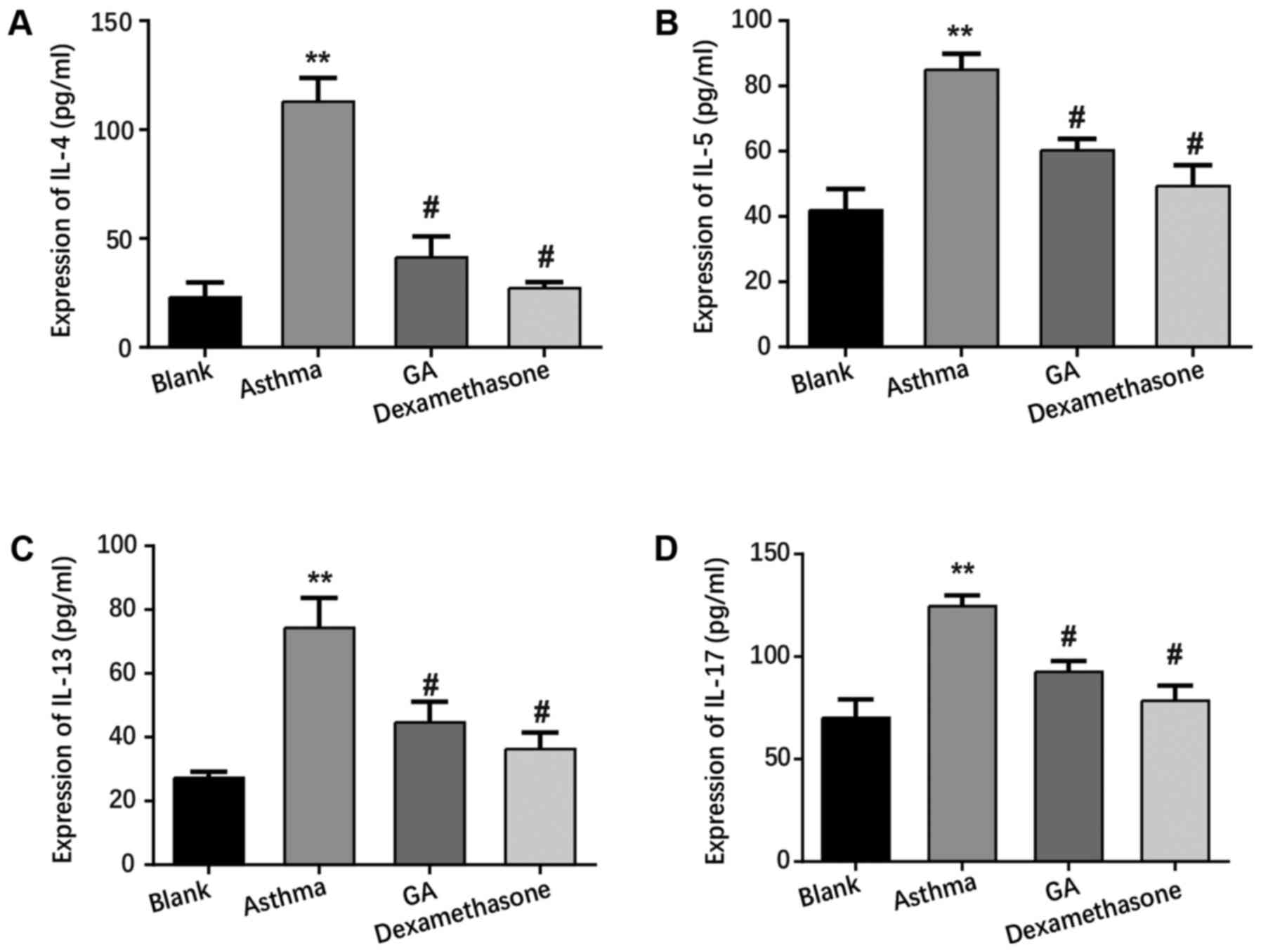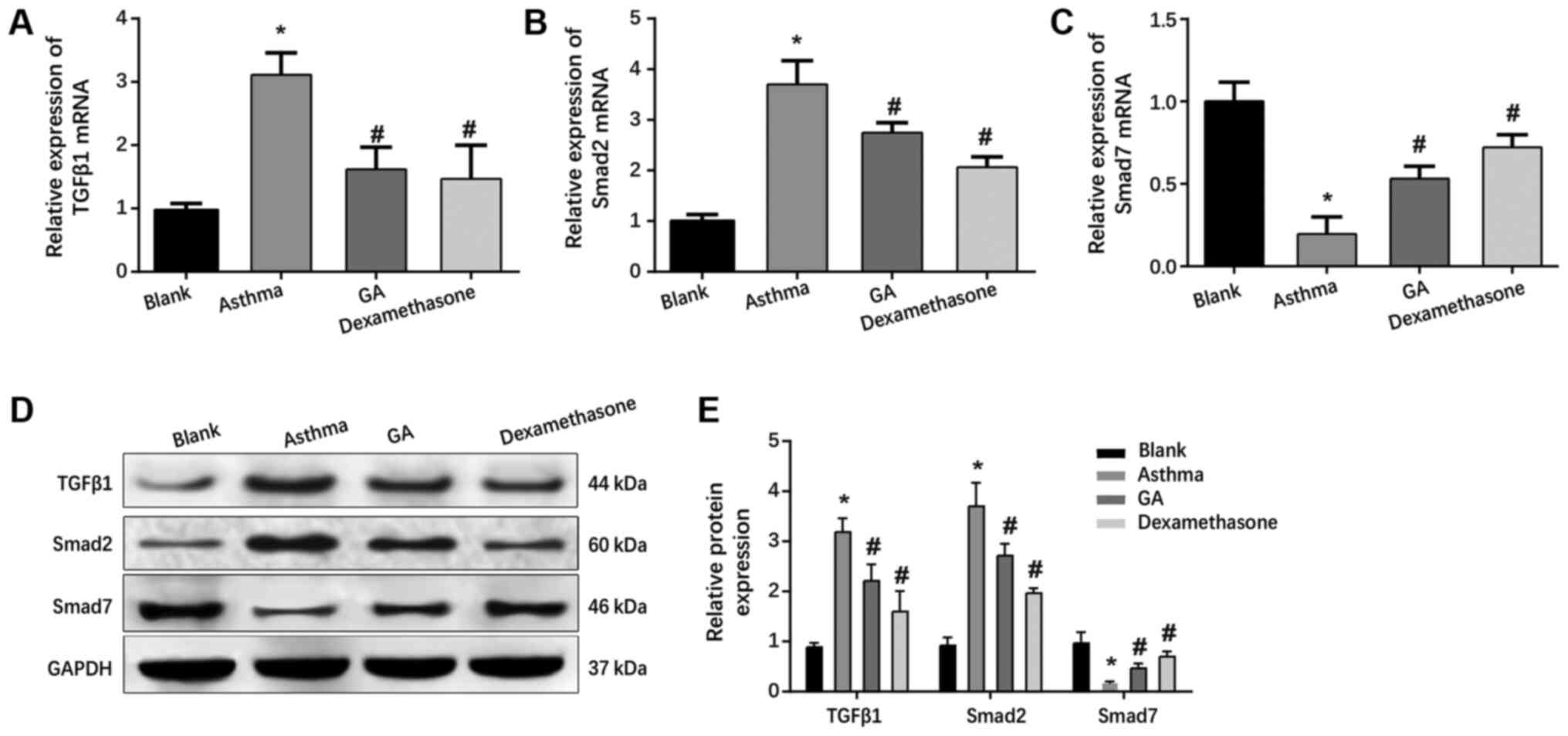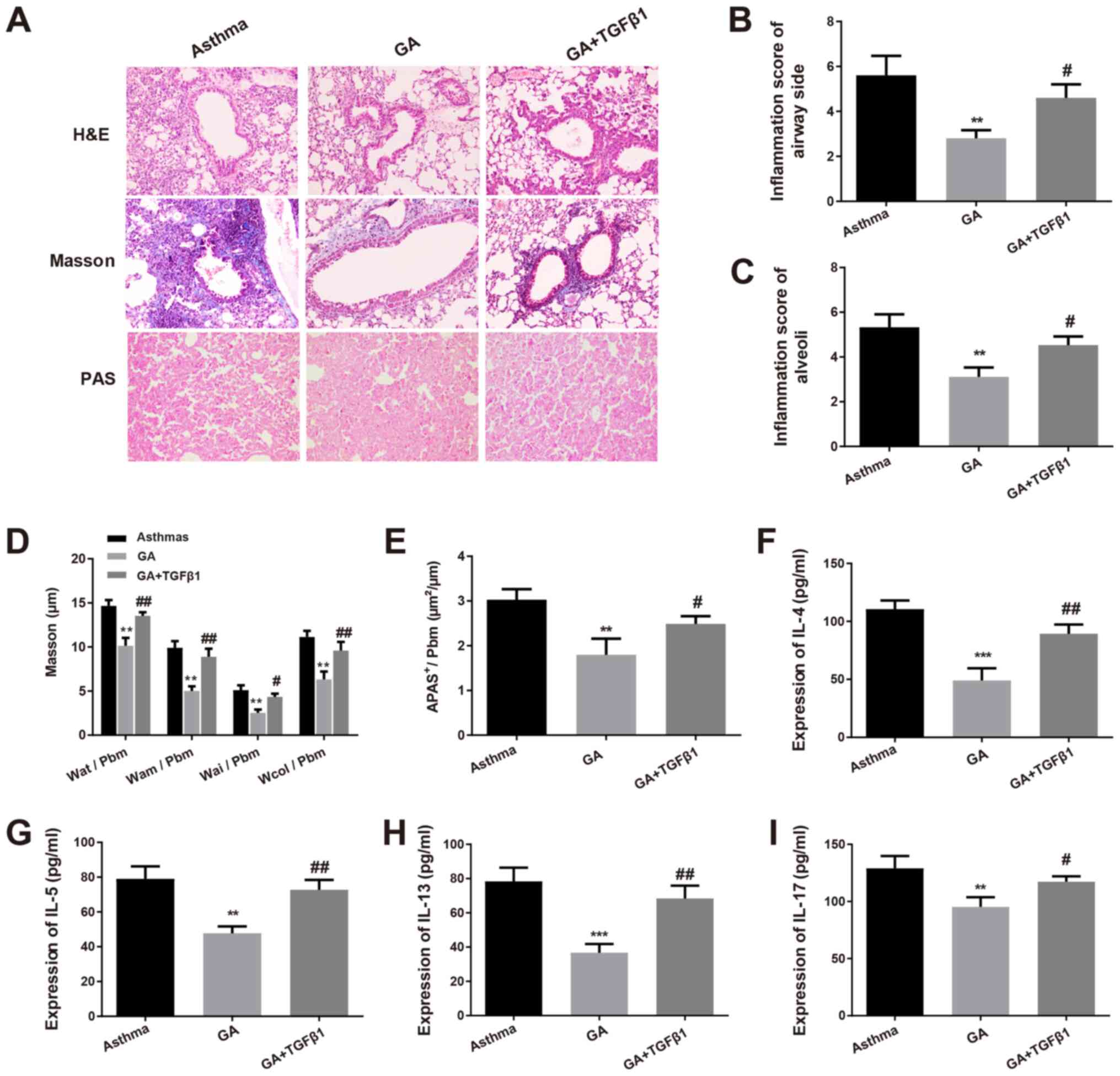|
1
|
Papi A, Brightling C, Pedersen SE and
Reddel HK: Asthma. Lancet. 391:783–800. 2018.PubMed/NCBI View Article : Google Scholar
|
|
2
|
Zhu X, Li Q, Hu G, Wang J, Hu Q, Liu Z, Wu
G and Zhong Y: BMS345541 inhibits airway inflammation and
epithelialmesenchymal transition in airway remodeling of asthmatic
mice. Int J Mol Med. 42:1998–2008. 2018.PubMed/NCBI View Article : Google Scholar
|
|
3
|
Jo A, Lee SH, Kim DY, Hong SJ, Teng MN,
Kolliputi N, Lockey RF, Schleimer RP and Cho SH: Mast cell-derived
plasminogen activator inhibitor type 1 promotes airway inflammation
and remodeling in a murine model of asthma. J Allergy Clin Immunol.
142:294–297.e5. 2018.PubMed/NCBI View Article : Google Scholar
|
|
4
|
Gupta A, Chakraborty S and Agrawal A:
Molecular and Genomic Basis of Bronchial Asthma. In: Clinical
Molecular Medicine. Academic Press, pp353-366, 2020.
|
|
5
|
Wu P, Xu B, Shen A, He Z, Zhang CJ, Ming
WK and Shen K: The economic burden of medical treatment of children
with asthma in China. BMC Pediatr. 20(386)2020.PubMed/NCBI View Article : Google Scholar
|
|
6
|
Bao Z, Zhang P, Yao Y, Lu G, Tong Z, Yan
B, Tu L, Yang G and Zhou J: Deguelin attenuates allergic airway
inflammation via inhibition of NF-κB pathway in mice. Int J Biol
Sci. 13:492–504. 2017.PubMed/NCBI View Article : Google Scholar
|
|
7
|
Cho IH, Choi YJ, Gong JH, Shin D, Kang MK
and Kang YH: Astragalin inhibits autophagy-associated airway
epithelial fibrosis. Respir Res. 16(51)2015.PubMed/NCBI View Article : Google Scholar
|
|
8
|
Li Y, Wang H and Yang X: Effects of
catalpol on bronchial asthma and its relationship with cytokines. J
Cell Biochem. 120:8992–8998. 2019.PubMed/NCBI View Article : Google Scholar
|
|
9
|
Sung JE, Lee HA, Kim JE, Yun WB, An BS,
Yang SY, Kim DS, Lee CY, Lee HS, Bae CJ and Hwang DY:
Saponin-enriched extract of Asparagus cochinchinensis alleviates
airway inflammation and remodeling in ovalbumin-induced asthma
model. Int J Mol Med. 40:1365–1376. 2017.PubMed/NCBI View Article : Google Scholar
|
|
10
|
Fouladi S, Masjedi M, Ghasemi R, Hakemi MG
and Eskandari N: The in vitro impact of glycyrrhizic acid on
CD4+ T lymphocytes through OX40 receptor in the patients
with allergic rhinitis. Inflammation. 41:1690–1701. 2018.PubMed/NCBI View Article : Google Scholar
|
|
11
|
Qu L, Chen C, He W, Chen Y, Li Y, Wen Y,
Zhou S, Jiang Y, Yang X, Zhang R and Shen L: Glycyrrhizic acid
ameliorates LPS-induced acute lung injury by regulating autophagy
through the PI3K/AKT/mTOR pathway. Am J Transl Res. 11:2042–2055.
2019.PubMed/NCBI
|
|
12
|
Su X, Wu L, Hu M, Dong W, Xu M and Zhang
P: Glycyrrhizic acid: A promising carrier material for anticancer
therapy. Biomed Pharmacother. 95:670–678. 2017.PubMed/NCBI View Article : Google Scholar
|
|
13
|
Gao L, Tang H, He H, Liu J, Mao J, Ji H,
Lin H and Wu T: Glycyrrhizic acid alleviates bleomycin-induced
pulmonary fibrosis in rats. Front Pharmacol. 6(215)2015.PubMed/NCBI View Article : Google Scholar
|
|
14
|
Wu Q, Tang Y, Hu X, Wang Q, Lei W, Zhou L
and Huang J: Regulation of Th1/Th2 balance through OX40/OX40L
signalling by glycyrrhizic acid in a murine model of asthma.
Respirology. 21:102–111. 2016.PubMed/NCBI View Article : Google Scholar
|
|
15
|
Liu YD, Sun X, Zhang Y, Wu HJ, Wang H and
Yang R: Protocatechuic acid inhibits TGF-beta1-induced
proliferation and migration of human airway smooth muscle cells. J
Pharmacol Sci. 139:9–14. 2019.PubMed/NCBI View Article : Google Scholar
|
|
16
|
Ojiaku CA, Yoo EJ and Panettieri RA Jr:
Transforming growth factor β1 function in airway remodeling and
hyperresponsiveness. The missing link? Am J Respir Cell Mol Biol.
56:432–442. 2017.PubMed/NCBI View Article : Google Scholar
|
|
17
|
Macias MJ, Martin-Malpartida P and
Massague J: Structural determinants of Smad function in TGF-β
signaling. Trends Biochem Sci. 40:296–308. 2015.PubMed/NCBI View Article : Google Scholar
|
|
18
|
van der Kraan PM: Differential role of
transforming growth factor-beta in an osteoarthritic or a healthy
joint. J Bone Metab. 25:65–72. 2018.PubMed/NCBI View Article : Google Scholar
|
|
19
|
Ogden BE, Pang William W, Agui T and Lee
BH: Laboratory animal laws, regulations, guidelines and standards
in China Mainland, Japan, and Korea. ILAR J. 57:301–311.
2016.PubMed/NCBI View Article : Google Scholar
|
|
20
|
Shi YX, Dai X, Wang LJ, et al: Effect of
ligustrazine on airway inflammation and airway remodeling in
asthmatic mice by regulating TGF-β1/Smad signaling pathway. Drugs
Clinic. 1:20–26. 2019.
|
|
21
|
Livak KJ and Schmittgen TD: Analysis of
relative gene expression data using real-time quantitative PCR and
the 2(-Delta Delta C(T)) method. Methods. 25:402–408.
2001.PubMed/NCBI View Article : Google Scholar
|
|
22
|
Nakagami Y, Favoreto S Jr, Zhen G, Park
SW, Nguyenvu LT, Kuperman DA, Dolganov GM, Huang X, Boushey HA,
Avila PC and Erle DJ: The epithelial anion transporter pendrin is
induced by allergy and rhinovirus infection, regulates airway
surface liquid, and increases airway reactivity and inflammation in
an asthma model. J Immunol. 181:2203–2210. 2008.PubMed/NCBI View Article : Google Scholar
|
|
23
|
Blasi F, Bettoncelli G, Canonica GW,
Centanni S, Crimi N, DiMaria G, Gasparini S, Gentili G, Girbino G,
Mereu C, et al: The management of asthma in the phenotype and
biomarker era: The proposal of a new diagnostic-therapeutic model.
J Asthma. 53:665–667. 2016.PubMed/NCBI View Article : Google Scholar
|
|
24
|
Liang B, Guo XL, Jin J, Ma YC and Feng ZQ:
Glycyrrhizic acid inhibits apoptosis and fibrosis in
carbon-tetrachloride-induced rat liver injury. World J
Gastroenterol. 21:5271–5280. 2015.PubMed/NCBI View Article : Google Scholar
|
|
25
|
Zhao H, Liu Z, Shen H, Jin S and Zhang S:
Glycyrrhizic acid pretreatment prevents sepsis-induced acute kidney
injury via suppressing inflammation, apoptosis and oxidative
stress. Eur J Pharmacol. 781:92–99. 2016.PubMed/NCBI View Article : Google Scholar
|
|
26
|
Zhao H, Zhao M, Wang Y, Li F and Zhang Z:
Glycyrrhizic acid prevents sepsis-induced acute lung injury and
mortality in rats. J Histochem Cytochem. 64:125–137.
2016.PubMed/NCBI View Article : Google Scholar
|
|
27
|
Tang X, Nian H, Li X, Yang Y, Wang X, Xu
L, Shi H, Yang X and Liu R: Effects of the combined extracts of
Herba epimedii and Fructus Ligustrilucidi on airway
remodeling in the asthmatic rats with the treatment of budesonide.
BMC Complement Altern Med. 17(380)2017.PubMed/NCBI View Article : Google Scholar
|
|
28
|
Pang H, Huang T, Song J, Li D, Zhao Y and
Ma X: Inhibiting HMGB1 with glycyrrhizic acid protects brain injury
after DAI via its anti-inflammatory effect. Mediators Inflamm.
2016(4569521)2016.PubMed/NCBI View Article : Google Scholar
|
|
29
|
Yu JY, Ha JY, Kim KM, Jung YS, Jung JC and
Oh S: Anti-inflammatory activities of licorice extract and its
active compounds, glycyrrhizic acid, liquiritin and liquiritigenin,
in BV2 cells and mice liver. Molecules. 20:13041–13054.
2015.PubMed/NCBI View Article : Google Scholar
|
|
30
|
Fouladi S, Masjedi M, Ganjalikhani Hakemi
M and Eskandari N: The review of in vitro and in vivo studies over
the glycyrrhizic acid as natural remedy option for treatment of
allergic asthma. Iran J Allergy Asthma Immunol. 18:1–11.
2019.PubMed/NCBI
|
|
31
|
Wang C, Zheng M, Choi Y, Jiang J, Li L, Li
J, Xu C, Xian Z, Li Y, Piao H, et al: Cryptotanshinone attenuates
airway remodeling by inhibiting crosstalk between tumor necrosis
factor-like weak inducer of apoptosis and transforming growth
factor beta 1 signaling pathways in asthma. Front Pharmacol.
10(1338)2019.PubMed/NCBI View Article : Google Scholar
|
|
32
|
Lee HY, Kim IK, Yoon HK, Kwon SS, Rhee CK
and Lee SY: Inhibitory effects of resveratrol on airway remodeling
by transforming growth factor-beta/Smad signaling pathway in
chronic asthma model. Allergy Asthma Immunol Res. 9:25–34.
2017.PubMed/NCBI View Article : Google Scholar
|
|
33
|
Qu ZH, Yang ZC, Chen L, Lv ZD, Yi MJ and
Ran N: Inhibition airway remodeling and transforming growth
factor-β1/Smad signaling pathway by astragalus extract in asthmatic
mice. Int J Mol Med. 29:564–568. 2012.PubMed/NCBI View Article : Google Scholar
|
|
34
|
Jeon WY, Shin IS, Shin HK, Jin SE and Lee
MY: Aqueous extract of Gumiganghwal-tang, a traditional herbal
medicine, reduces pulmonary fibrosis by transforming growth
factor-β1/Smad signaling pathway in murine model of chronic asthma.
PLoS One. 11(e0164833)2016.PubMed/NCBI View Article : Google Scholar
|
|
35
|
Feng Y, Yang C, Yang W and Jiang T: Effect
of dexamethasone on TGF-β1/Smad3 signalling pathway in airway
remodelling model of asthmatic rats. J Coll Physicians Surg Pak.
29:537–540. 2019.PubMed/NCBI View Article : Google Scholar
|
|
36
|
Wang J, Li HY, Wang HS and Su ZB:
MicroRNA-485 modulates the TGF-β/Smads signaling pathway in chronic
asthmatic mice by targeting Smurf2. Cell Physiol Biochem.
51:692–710. 2018.PubMed/NCBI View Article : Google Scholar
|
|
37
|
Chen L, Yang T, Lu DW, Zhao H, Feng YL,
Chen H, Chen DQ, Vaziri ND and Zhao YY: Central role of
dysregulation of TGF-β/Smad in CKD progression and potential
targets of its treatment. Biomed Pharmacother. 101:670–681.
2018.PubMed/NCBI View Article : Google Scholar
|
|
38
|
Hu HH, Chen DQ, Wang YN, Feng YL, Cao G,
Vaziri ND and Zhao YY: New insights into TGF-β/Smad signaling in
tissue fibrosis. Chem Biol Interact. 292:76–83. 2018.PubMed/NCBI View Article : Google Scholar
|
|
39
|
Walton KL, Johnson KE and Harrison CA:
Targeting TGF-β mediated SMAD signaling for the prevention of
fibrosis. Front Pharmacol. 8(461)2017.PubMed/NCBI View Article : Google Scholar
|
|
40
|
Briones-Orta MA, Tecalco-Cruz AC,
Sosa-Garrocho M, Caligaris C and Macias-Silva M: Inhibitory Smad7:
Emerging roles in health and disease. Curr Mol Pharmacol.
4:141–153. 2011.PubMed/NCBI
|
|
41
|
Sugiura H, Liu X, Duan F, Kawasaki S, Togo
S, Kamio K, Wang XQ, Mao L, Ahn Y, Ertl RF, et al: Cultured lung
fibroblasts from ovalbumin-challenged ‘asthmatic’ mice differ
functionally from normal. Am J Respir Cell Mol Biol. 37:424–430.
2007.PubMed/NCBI View Article : Google Scholar
|


















